Let's take a journey through the next few pages together. Get to the end, and I promise you'll have a better fitting bra size.
HerRoom CEO/Founder
The actual shape of your breasts and your body composition can have an enormous impact on how a bra will fit and look on you. The following is a list of additional considerations that should be taken into account before deciding on the best bra choice for you.
- TOMIMA
Many women have erect nipples all the time, and/or nipples that are very prominent when erect. This is quite a common occurrence. Women with breast implants could discover after surgery that their nipples are now in a constant state of erection. Several bra styles on the market can mask this and give you a smooth look.
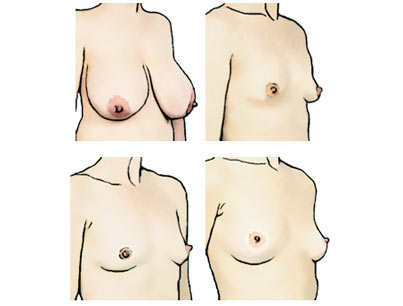
An areola is the circular, darkened area around the nipple on each breast. Some areolas measure less than an inch in diameter, while others can measure over 3 inches wide. And, their color and contrast can vary to almost the same color as your skin.
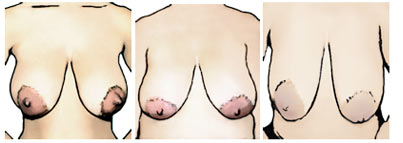
A woman is born with sloping and/or narrow shoulders, or they can appear later in life. These types of shoulders are problematic for keeping a bra’s shoulder strap in place.
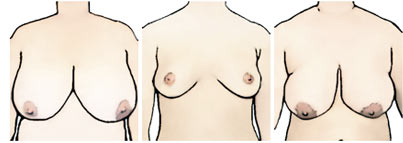
It can be common for women to have more breast tissue in their upper breast than in their lower breast. This breast shape gives breasts a youthful full look. However, the breast apex (nipple) is positioned lower down the breast and can give the illusion of looking saggy.
These breasts will have very high mounding in a bra, and the nipple will need to be positioned in the cup lower than where the apex of the cup has been designed by the manufacturer. The upper breast tissue will often not all fit into the cup.
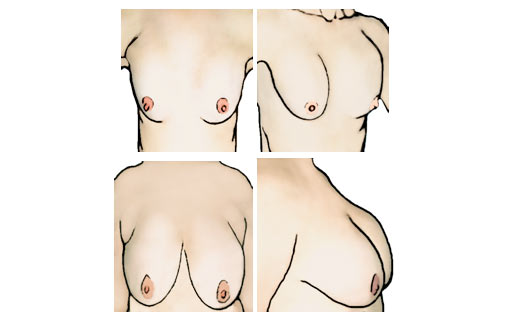
A distended high tummy is one where the upper crest of the tummy comes up between the breasts. This high tummy is common among overweight women, and its distention is most commonly a pillow of fatty tissue. Along with a distended high tummy can be outward pointing breasts. It is more unusual to have a distended high tummy if you are at your goal weight.
Most petite and short-waisted women will have a distended high tummy if they’re over their goal weight. In all cases, the shape of a bra’s center panel will be key to a bra fitting and feeling comfortable.
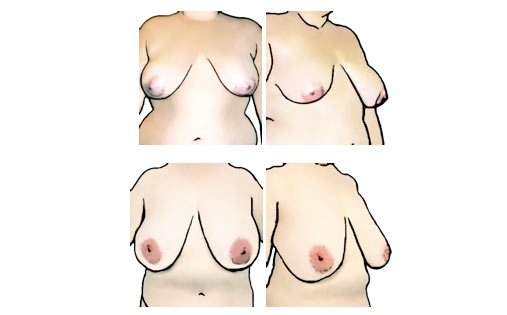
Many women have an under-bust crease that follows the same circular shape as a bra’s underwire. However, women can have an under-bust crease that is not this circular shape – their crease stays horizontal rather than curving up under their arm, or sections of their crease are straight rather than curved.
For many overweight women, a non-traditional shape is a common occurrence, and these women also tend to have a distended high tummy as well. For example, their crease may not curve up under their arm. So an underwire bra could rest on top of breast tissue, which is rather painful.
This phenomenon is more unusual for women of average weight. Nothing has caused this; it simply occurred during breast development. Not sure what your breast crease looks like? Stand in front of a mirror and lift your arms up. This will give you your best view.
With arms at rest, there is a flap of skin along your sides that is parallel with the floor. Common among much older women and women who have had tremendous weight loss, this symptom is more unusual among younger, average weight women.
This skin flap is symptomatic of wearing the same ill-fitting or too tight bra band for many years. Having a variety of bra styles with varying bands that can be alternately worn throughout the week can prevent the creation of this skin flap on average weight women.
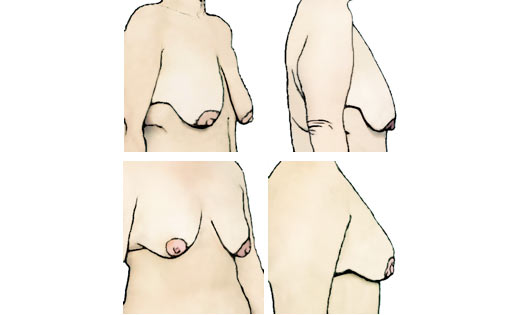
A prominent breast bone has the sternum between the breasts protruding outward, thus giving a bowed-like appearance to the front of the chest. Also called "pigeon chest," "barrel chest," or "pectus carinatum," this unusual chest bowing can range from slight to significant- with significant being rare. With a prominent breast bone, the breasts will probably have an outward pointing apex, and the breast separation will tend to be wide-set. This rather rare condition can also be the result of ribs spreading during pregnancy, or an over-developed diaphragm – common in swimmers and opera singers.
Underwires will be uncomfortable because they will not wrap naturally around a bowed chest. The underwires coming together at the sternum will have a tendency to tilt away from the body due to the distended sternum. However, slightly bending each wire in its middle will create a more rounded shape and will allow the wires to rest against the chest. This subtle bend will also wrap the underwire around your sides instead of sticking out and poking your underarm every time it moves forward.
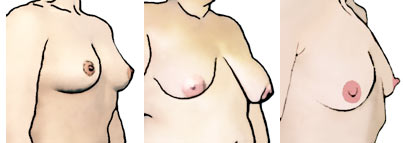
The sternum between the breasts can be recessed, creating a hollow. This is known as a hollow breast bone. Also called pectus excavatum, this unusual hollow recess can vary from slight to significant - with a significant hollow being quite rare. A hollow chest of any magnitude will never see the center panel of a bra resting on the sternum – there will always be a slight gap. But other than this, most bras will fit. Cleavage is possible with C cup sizes or larger.
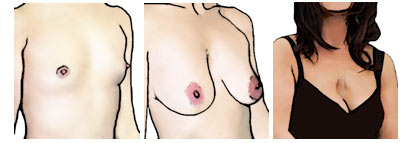
Spine curvature, also known a scoliosis, occurs with varying degrees of severity in 2% of all women. Any type of spine curvature will impact the way a bra fits. The most problematic issues occur when there is an outward spine curve on the back at or near the bra line.
This will increase a woman’s band size, and can cause the back of a woman’s bra to either creep/roll up or pull down her back. And, of course, this movement wreaks havoc on the bra straps; they are either falling off the shoulders or feeling too tight.
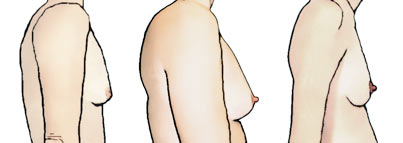
Symmastia is a rare congenital condition where breast tissue has connected both breasts across the center sternum. The look of symmastia (also called "uniboob" or "breadloafing" and alternately spelled symnastia) can sometimes occur after implant surgery. The surgeon placed the implants too close to the midline of the chest and the breasts do not have clear separation. In both instances, this condition can be surgically corrected.
The center panel of a bra needs to be considered carefully. The center panel of most bras will not rest correctly at the sternum. Try and find bras with a low center panel that rests just below the connective tissue for best fit. Most with symmastia will have cleavage but it will look non-traditional.
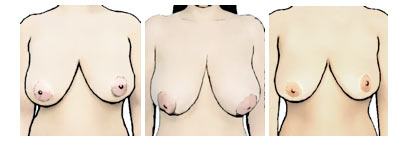
Latex is a rubber that comes from specific plants. It has a protein that can cause an allergic reaction in some people. And, the reaction can range from sneezing to anaphylactic shock, which requires immediate attention. Originally, elastic was made using latex. Today, almost all elastic found in underwear is made with spandex.
So, why is it possible to have an allergic reaction to elastics today? The answer is that much of the world’s elastic is made in factories where latex is present. Small air-born latex particles can wind up in the spandex elastic. So, someone with the allergy can still experience a reaction. And, encasing elastic in fabric will not protect the wearer; as the garment ages and is washed, a latex particle in the elastic can work its way to the surface of the fabric and cause a reaction.
Some feel they too have an allergy to spandex. However, allergen chemists will disagree; they know the chemical make-up of spandex is totally synthetic like nylon or polyester. It therefore contains no allergen.
A typical latex allergic reaction with bras occurs first under the breasts and under the arms. It can range from an itching, to redness, to blisters or worse. Elastic in a bra’s straps is almost guaranteed to be clean of any latex. Strap elastic is a woven product and latex is not present in these factories. Stretch laces are also a nylon/spandex blend without the use of any latex.
No retailer will know for certain if an undergarment is latex-free. After all, they do not make the garments. But, here are some tips when making your lingerie selections:
A woman 5’3" or shorter is considered petite in stature. And, with this shorter height comes bra fit issues as well. For example, most longline bras and bustiers will prove too long for a petite figure. And, shapewear, which is designed for women 5’4" to 5’8", will often be too long in the torso. At this time, there is no petite shapewear manufacturer. Your best shapewear option will be to purchase a top and bottom piece rather than struggle to find one piece that likely will not fit properly.
At HerRoom, we have two petite categories: petite and petite plus size. Bras classified as "petite" at HerRoom are bras where the size range in band and cup sizing is small and limited. Additionally, the cups on petite classified bras are sewn closer together and have smaller cup coverage; the straps are also shorter in length. These design modifications go a long way in helping a petite woman get a better bra fit.
HerRoom also has a "petite plus size" classification. These bras have been identified as being a better fit for a full-busted woman who is petite in stature. Working closely with all our manufacturers, we have identified those larger cup-sized and banded bras that have shorter underwires, and a more pared-down cup size. Again, these design modifications help to give a plus-sized petite woman a better bra fit.
Women taller than 5’8" probably know that they can have fit issues with bras and shapewear – especially if long torso’d. Some tall women have all their height in their legs, so most bras and shapewear fit. But, if your torso is long, some bras don’t have straps long enough to accommodate you, and shapewear – made to fit women 5’4" to 5’8" – will be too short in the waist. And shapewear bodysuits without enough crotch adjustment simply won’t fit.
At HerRoom, every bra we offer for sale includes a back view. This view shows you how much strap adjustment is available and if there will be enough strap length to possibly fit you. Additionally, any page of search results on our site has a mouse-over feature that will change a front view image instantly to a back image. No need to click through to our product page to see what the back of one of our bras looks like; simply mouse over our image. We put this in place specifically to help our tall customers make more educated choices.
Find your best bra size
Fast
No measuring tape needed
Let's take a journey through the next few pages together. Get to the end, and I promise you'll have a better fitting bra size.
HerRoom CEO/Founder
Find your best
Bra Styles
By Tomima
You know your bra size. But, do you know your breasts? Sounds like a funny question, but certain bras styles and features work better for some breasts and not for others.
Answer the following questions, and I promise your new bras will make you look younger and thinner!
We are sorry we are unable to assist you further.
